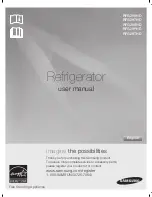
You can solve many common appliance problems easily, saving you the cost of a possible service call.
Try the suggestions below to see if you can solve the problem before calling the servicer.
PROBLEM
POSSIBLE CAUSE & REMEDY
Refrigerator does not work
A. Refrigerator is not switched on. Turn on the temperature control
dial. It may be in the OFF, “0” position
B. Unit is not plugged in or plug is loose. Plug in the refrigerator.
C. Fuse has blown or is defective. Check fuse, replace if necessary.
D. Wall power socket is defective. To be corrected by a qualified
electrician.
The food is too cold
Temperature is not properly adjusted. Set the temperature control
dial to a warmer setting.
The food is too warm
A. Temperature is not properly adjusted. Set the temperature
control dial to a cooler setting
B. Door was open for an extended period. Open the door only as
long as necessary. Check door gasket for proper seal.
C. A large quantity of warm food was placed in the refrigerator
within the last 24 hours. Set the temperature control dial to a
colder setting temporarily.
D. The refrigerator is near a heat source. Please look in the
“Protection From Heat and Moisture” section.
Heavy build-up of frost,
NOTE
This is normal during high humidity periods. Frequent door
possibly also on the door seal
openings will also cause heavy frost buildup
Door seal is not air-tight (possibly after reversing the door).
Carefully warm the leaking sections of the door gasket with a hair
dryer (on a cool setting). At the same time, shape the warmed
door seal by hand such that it sits correctly.
Popping or cracking sounds
When compressor comes on. This is a normal sound of coolant
flowing through condenser coils.
Refrigerator door does not
The refrigerator door is not properly aligned. Re-align the
shut properly
refrigerator door. Refer to the “Door Alignment” section.
Ensure nothing is blocking the door.
Refrigerator has an odor
A. Foods not properly sealed. Remove any contaminated foods.
B. Interior needs cleaning. Please refer to “Cleaning and Care”
section
9
TROUBLESHOOTING GUIDE
8
CARE AND CLEANING (cont.)
DEFROSTING THE FREEZER COMPARTMENT
• Defrost the freezer compartment when the frost accumulated is about 1/8” thick.
• Set the temperature control dial to “0” before defrosting. Remove all contents from the freezer com-
partment and leave the door open until ice and frost dissolve thoroughly. Make sure the drip tray is
in place and unplug the unit. After defrosting, empty water from drip tray and wipe the compartment
dry with a soft cloth and then adjust the temperature control dial to the desired position.
NOTE
- In case you want to speed up the defrosting, you may put a bowl of warm water (about 122°F) into
the refrigerator.
- Do not heat the evaporator directly with hot water or hair dryer while defrosting.
Doing so will
damage the freezer compartment.
- Never use a sharp or metallic instrument to remove frost as it may damage the refrigerator and
puncture the cooling coils. It will also void the warranty. We recommend using a plastic scraper.
ENERGY SAVING TIPS
• The refrigerator should be located in the coolest area of the room, away from heat-producing
appliances or heating ducts, and out of direct sunlight.
• Let hot foods cool to room temperature before placing in the refrigerator.
Overloading the
refrigerator forces the compressor to run longer and thus increase energy consumption. Foods that
refrigerate too slowly may lose quality or spoil.
• Be sure to wrap foods properly, and wipe containers dry before placing in the refrigerator.
• The shelves should not be lined with aluminium foil, wax paper, or paper towels. This will interfere
with cold air circulation, making the refrigerator less efficient.
• Organize food to reduce door openings and extended searches. Remove as many items as needed at
one time, and close the door as soon as possible.























